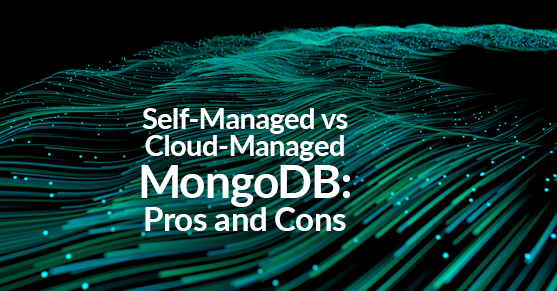MongoDB is a popular NoSQL database management system known for its flexibility, scalability, and ease of use. Developers widely use it to build web applications, mobile applications, and other software systems. In addition, MongoDB can be used as a self-managed solution, where developers need to set up and manage the database themselves, or as a cloud-managed solution, where a cloud service provider manages the database.
This post will explore the pros and cons of using a self-managed version of MongoDB versus the various cloud options available.
Self-managed MongoDB
Pros:
- Complete control: When using a self-managed version of MongoDB, developers have full control over the database configuration, maintenance, and upgrades. This allows for greater customization and flexibility.
- Cost-effective: A self-managed version of MongoDB can be less expensive than cloud-managed options since there are no additional fees for the cloud service.
- High performance: A self-managed version of MongoDB can be optimized for high performance since developers have full control over the hardware and software configuration.
Cons:
- Maintenance overhead: Maintaining a self-managed version of MongoDB requires significant time and effort, including software updates, hardware upgrades, and security patches.
- Scalability: Scaling a self-managed version of MongoDB can be challenging since it requires adding additional hardware and configuring the database accordingly.
- Security: Ensuring the security of a self-managed version of MongoDB requires expertise in database security best practices, including access control, encryption, and vulnerability management.
Cloud-managed MongoDB
Pros:
- Low maintenance: Cloud-managed MongoDB options require minimal maintenance since the cloud service provider manages the database.
- Scalability: Cloud-managed MongoDB options can scale easily, either automatically or through manual configuration, to handle large amounts of data and traffic.
- High availability: Cloud-managed MongoDB options offer high availability by replicating data across multiple servers or data centers.
Cons:
- Limited control: Cloud-managed MongoDB options offer limited control over the database configuration, maintenance, and upgrades since the cloud service provider manages these.
- Additional cost: Cloud-managed MongoDB options can be more expensive than a self-managed version of MongoDB due to the additional fees for the cloud service.
- Performance limitations: Cloud-managed MongoDB options can have performance limitations due to the shared nature of cloud infrastructure and potential network latency.
Available Cloud-managed MongoDB Options
- Amazon Web Services (AWS): AWS provides a fully managed MongoDB service called Amazon DocumentDB, which is compatible with MongoDB and offers high availability, scalability, and security.
- MongoDB Atlas: MongoDB Atlas is a fully managed cloud database service that runs on AWS, Azure, and Google Cloud Platform. It offers a range of features, including automatic scaling, global distribution, and data encryption.
- Google Cloud Platform (GCP): GCP offers a fully managed MongoDB service called Cloud Firestore, a NoSQL document database with real-time updates and automatic scaling.
- Microsoft Azure: Azure offers a fully managed MongoDB service called Azure Cosmos DB, a globally distributed, multi-model database service that delivers high availability, low latency, and automatic scaling.
- IBM Cloud: IBM Cloud offers a fully managed MongoDB service called IBM Cloudant, which is a distributed database that delivers high availability, scalability, and data durability.
Conclusion
Choosing between a self-managed version of MongoDB and a cloud-managed MongoDB option depends on the specific needs and requirements of the project. For example, self-managed versions of MongoDB can provide greater control and cost-effectiveness but require significant maintenance overhead. On the other hand, cloud-managed MongoDB options provide ease of use, scalability, and high availability but offer limited control and can be more expensive.
When deciding, it’s essential to consider factors such as the project’s size, budget, performance requirements, and expertise in database management. Ultimately, the choice depends on the trade-offs between control, cost, and ease of use that are most important to the project.
For questions or more information, please reach out to us!

